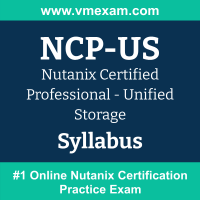 The Nutanix NCP-US exam preparation guide is designed to provide candidates with necessary information about the Unified Storage exam. It includes exam summary, sample questions, practice test, objectives and ways to interpret the exam objectives to enable candidates to assess the types of questions-answers that may be asked during the Nutanix Certified Professional - Unified Storage (NCP-US) exam.
The Nutanix NCP-US exam preparation guide is designed to provide candidates with necessary information about the Unified Storage exam. It includes exam summary, sample questions, practice test, objectives and ways to interpret the exam objectives to enable candidates to assess the types of questions-answers that may be asked during the Nutanix Certified Professional - Unified Storage (NCP-US) exam.
It is recommended for all the candidates to refer the NCP-US objectives and sample questions provided in this preparation guide. The Nutanix Unified Storage certification is mainly targeted to the candidates who want to build their career in Professional Level domain and demonstrate their expertise. We suggest you to use practice exam listed in this cert guide to get used to with exam environment and identify the knowledge areas where you need more work prior to taking the actual Nutanix Certified Professional - Unified Storage exam.
Nutanix NCP-US Exam Summary:
|
Exam Name
|
Nutanix Certified Professional - Unified Storage |
| Exam Code | NCP-US |
| Exam Price | $199 USD |
| Duration | 120 minutes |
| Number of Questions | 75 |
| Passing Score | 3000/1000-6000 |
| Recommended Training / Books | Nutanix Unified Storage Administration (NUSA) |
| Schedule Exam | Nutanix |
| Sample Questions | Nutanix NCP-US Sample Questions |
| Recommended Practice | Nutanix Certified Professional - Unified Storage (NCP-US) Practice Test |
Nutanix Unified Storage Syllabus:
| Section | Objectives |
|---|---|
Deploy and Upgrade Nutanix Unified Storage |
|
| Identify the steps to deploy Files |
Knowledge: - Identify prerequisites and limitations for Files deployment - Identify appropriate client and storage networks - Ensure NTP, DNS and Active Directory Services have been correctly configured - Identify supported protocols - Describe how to onboard to Data Lens - Describe how to deploy File Analytics - Identify subdomains vs. folder structures for FQDN pathing |
| Identify the steps to deploy Objects |
Knowledge: - Identify prerequisites and limitations for Objects deployment - Ensure NTP, DNS, and SPN have been correctly configured - Validate connectivity before handoff |
| Perform upgrades/maintenance for Files/Objects implementations |
Knowledge: - Determine Files/Objects dependencies on AOS - Maintain impact for Files and Objects (i.e. distributed versus standard shares) - Understand when to scale up/scale out |
| Given a scenario, determine product and sizing parameters |
Knowledge: - Determine capacity and performance requirements for Files/Objects - Determine capacity and performance requirements for Volumes - Determine network segmentation requirements of each product - Add/Remove volumes to a Volume Group |
Configure and Utilize Nutanix Unified Storage |
|
| Configure Files with advanced features |
Knowledge: - Create CIFS, NFS, and multi-protocol shares - Configure Smart DR, File Analytics, and Smart Tiering - Onboard Nutanix File instances to Data Lens - Manage permissions - Block specific file types - Create an additional new Files server |
| Configure Volumes |
Knowledge: - Present Nutanix Volumes to physical servers - Present Nutanix Volumes to virtual machines - Add/Remove volumes to Volume Groups - Configure CHAP - Determine when to use cluster white lists versus volume white lists |
| Configure Objects |
Knowledge: - Validate connectivity within a Nutanix Objects environment - Generate access keys - Configure Nutanix Objects for endpoint access - Create and configure buckets - Create additional namespaces |
| Given a scenario, configure shares, buckets, and/or Volume Groups |
Knowledge:
|
| Determine the appropriate method to ensure data availability/recoverability |
Knowledge: - Given a scenario with RPO and RTO defined, determine the appropriate Nutanix local and remote platform solution - Given a scenario with RPO and RTO defined, determine the appropriate local and remote. backup basic recovery options |
Analyze and Monitor Nutanix Unified Storage |
|
| Utilize File Analytics for data security |
Knowledge: - Use anomalies to determine suspicious activity or abnormal behavior
- Audit file access, usage, and modifications
- Detect ransomware and other security threats |
| Describe how to monitor performance and usage |
Knowledge: - Identify when to scale up/out Files and Objects clusters - Identify metrics to determine when to scale up/out - Identify performance constraints from a cluster utilization perspective |
| Describe the use of Data Lens for data security |
Knowledge: - Describe use cases - Identify requirements and supported features - Describe Smart Tiering requirements and recommendations - Differentiate File Analytics and Data Lens |
Troubleshoot Nutanix Unified Storage |
|
| Troubleshoot issues related to Files |
Knowledge: - Determine user permissions issues
- Determine shared visibility issues
- Determine why data is not being tiered |
| Troubleshoot issues related to Objects |
Knowledge: - Troubleshoot the reasons for deployment failures - Troubleshoot issues with read/write capabilities - Troubleshoot appropriate access for troubleshooting - Troubleshoot Objects with appropriate CLI commands - Troubleshoot issues with Objects replication - Troubleshoot issues related to Cloud Tiering |
| Troubleshoot issues related to Volumes |
Knowledge: - Determine proper authentication - Determine proper firewall settings - Determine correct IQNs/whitelists - Determine proper iSCSI timeout settings - Determine the basic steps needed to add a capacity to a VG - Troubleshoot the inability to see newly added capacity |
| Explain Data Management processes for Files and Objects |
Knowledge: - Describe technologies used to ensure data availability
- Describe HA capabilities within Files and Objects |
| Troubleshoot a failed upgrade for Files/Objects |
Knowledge: - Determine AOS/Prism Central compatibility issues and requirements - Determine the appropriate logs to review - Determine File Analytics compatibility issues and requirements |
